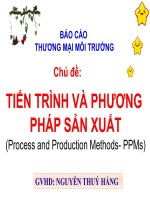Capital investment appraisal appraisal process and methods
Bạn đang xem bản rút gọn của tài liệu. Xem và tải ngay bản đầy đủ của tài liệu tại đây (2.61 MB, 35 trang )
Lecture 2- Capital Investment Appraisal: Appraisal
process and methods
Objectives:
Describe the nature of capital
investment appraisal
Apply the main investment appraisal
techniques
Recognise the limitations of investment
appraisal technique
1
Definition of Investment
• Any act which involves the sacrifice
of an immediate and certain level of
consumption in exchange for the
expectation of an increase in future
consumption.
• forgo the present consumption in
order to increase resources in future
2
Types of capital investment
Replacement of obsolete assets
Cost reduction e.g. IT system
Expansion e.g new building & equipment
Strategic proposal: improve delivery
service, staff training.
Diversification for risk reduction
3
Need for Investment Appraisal
Large amount of resources are involved
and wrong decisions could be costly
Difficult and expensive to reverse
Investment decisions can have a direct
impact on the ability of the organisation
to meet its objectives
4
Investment Appraisal Process
Stages:
identify objectives. What is it? Within the
corporate objectives?
Identify alternatives. Use CAD, CAM or
use external service.
Collect and analyse data. Examine the
technical and economic feasibility of the
project, cash flows etc.
5
Investment Appraisal Process
Stages:
decide which one to undertake
authorisation and implementation
review and monitor: learn from its
experience and try to improve future
decision - making.
6
Appraisal Methods
Payback method - length of time it
takes to repay the cost of initial
investment
7
Payback Period
Lecture Example 2.1
LBS Ltd uses the payback period as its sole
investment appraisal method. LBS invests
£30,000 to replace its computers and this
investment returns £9,000 annually for the five
years. From the information above evaluate the
investment using the payback. Assume that
£9,000 accrues evenly throughout the year.
8
Payback Period
Solution 2.1
Year
cash flow
•
•
•
•
•
0
1
2
3
4
5
Yearly cash flow
cumulative net
£
(30,000)
9,000
9,000
9,000
9,000
9,000
£
(30,000)
(21,000
(12,000)
(3,000)
6,000
15,000
Therefore 3years = 27,000 then 3000/9000 x 12 = 4
Payback period = 3 years 4months
9
Example 2.2
10
Example 2.2 solution
a) Undiscounted pay back
For A = 4 years
For B = 5 years
11
Example 2.2 solution
12
Example 2.2 solution
For A, payback is outside the
project’s life
For B payback is 6.25 yeas (how?)
13
Advantages and disadvantages of
payback
Read on page 13
14
Accounting Rate of Return (ARR)
16
Lecture Example 2.3
17
Example 2.3 - solution
Average Accounting Profit
(- 250 +1000 + 1000 + 20,750) / 4 = 5625
Average investment = 45,000 / 2 = 22500
ARR = (5625/22,500 x 100 = 25%
18
ARR
Read on:
Advantages and disadvantages
(page 14)
19
Appraisal Methods
• Net Present Value (NPV) - the
difference between the present values
of cash inflows and outflows of an
investment
• Opportunity cost of undertaking the
investment is the alternative of earning
interest rate in the financial market.
20
NPV
21
Definitions
• Present value:- the amount of money
you must invest or lend at the present
time so as to end up with a particular
amount of money in the future.
• Discounting: -finding the present
value of a future cash flow
22
Quick exercise
23
Example 2.4
A company can purchase a machine at the
price of £2200. The machine has a productive
life of three years and the net additions to cash
inflows at the end of each of the three years
are £770, £968 and £1331. The company can
buy the machine without having to borrow
and the best alternative is investment
elsewhere at an interest rate of 10%.
Evaluate the project using the
a) Net present value method.
b) Internal rate of return
24
Example 2.4: solution
25
Net Present Value
Lecture Example 2.5
A firm invest £180,000 in a project that
will give a net cash inflow of 50,000 in
real terms in each of the next six years.
Its real pre-tax cost of capital is 13%.
Required:
Calculate NPV
26




![global real estate investment trusts-people, process and management[team nanban][tpb]](https://media.store123doc.com/images/document/2014_11/05/medium_uiw1415172637.jpg)




